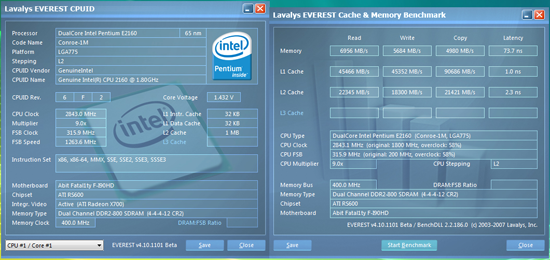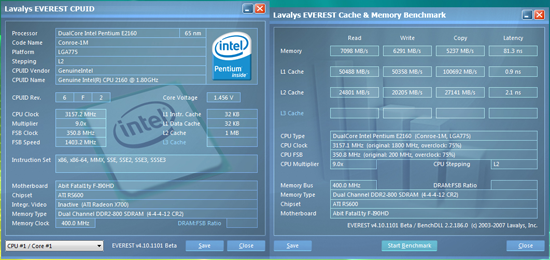µATX Part 1: ATI Radeon Xpress 1250 Performance Review
by Gary Key on August 28, 2007 7:00 AM EST- Posted in
- Motherboards
abit Fatality F-I90HD: FSB Overclocking
Our best results with the integrated graphics solutions and an E2160 was a final benchmark stable setting of 9x315 FSB resulting in a clock speed of 2843MHz, but it required a CPU voltage setting of 1.450V and Northbridge setting of 2.016V. The board was actually capable of running at 9x325 FSB but would consistently fail our game benchmarks. Vdroop was acceptable with a loss of around .02~.03V during load testing. Unlike the ASRock board, the BIOS does not support overclocking of the memory so we stayed with our best settings of 4-4-4-12 at DDR2-800.
Switching to discrete graphics, we had fairly good luck with this board up to 9x350 FSB and decided to stay at that level even though we could run up to 9x374 FSB. The reasoning behind this is that our first board fried itself after running at 9x370 during our benchmark testing. This appears to be a common issue with the early releases of the boards indicating the advertised quality components on the board are not exactly up to rigorous testing.
We think it is probably a combination of faulty manufacturing or component selection early on in production, plus the fact that PCI and PCI-E speeds are not adjustable and from all indications are somewhat tied synchronously to the FSB rates. Considering the BIOS options available in the ASRock board, we would have thought abit could have done better with the overclocking options available including additional memory timings and settings for the PCI and PCI-E clocks.
Our final 9x350FSB setting resulted in a CPU speed of 3157MHz with 1.475V required for the CPU and 1.872V for the Northbridge. Once again, memory speed stayed static at DDR2-800 with timings of 4-4-4-12. Our current board has over 400 hours of 24/7 benchmark testing at these settings so we feel comfortable with the voltages and settings utilized for this result. Resulting temps under load never exceeded 51C at these settings with idle temps hovering around 34C.
ASRock 4Core1333-FullHD: FSB Overclocking
This board is like the Tale of Two Cities, both good and bad depending on the BIOS utilized. We were able to reach a final benchmark stable setting of 9x305 FSB resulting in a clock speed of 2745MHz with the X1250 integrated graphics solution. The board reached a final 9x343 FSB setting with the HD 2600 XT installed. Unlike the abit board, this board offers the option to overclock the memory along with a standard DDR2-1066 setting, although buying memory that will do either is a waste if you use an E2160 CPU. That's the good news.
The bad news is the latest BIOS update that includes support for Pioneer's Blu-ray drive and also offers an improvement in disk and memory scores does not overclock for us. ASRock has been able to overclock their board with the latest BIOS, so we are shipping our test sample back for analysis.
There is more bad news if overclocking a board like this is interesting to you. The board does not support CPU multipliers and does not offer adjustable CPU voltages. The auto CPU voltage system does work to a certain degree as the board will increase voltages slightly, but the inability to go much over +0.05V means your overclocking rates will be subject to the quality of your CPU. Considering the wealth of BIOS options on this board that are designed with overclocking in mind, it is weird to us that CPU voltage options are not available.
| abit Fatality F-I90HD Overclocking Testbed | |
| Processor | Intel Pentium (Core 2 Based) E2160 Dual Core, 1.8GHz, 1MB Unified Cache, 9x Multiplier, 800FSB |
| CPU Voltage | 1.4500V, 1.4750V |
| Cooling | Scythe Ninja Mini |
| Power Supply | SeaSonic S-12 II 430W |
| Memory | OCZ HPC Reaper PC2-6400 (4x1GB) |
| Memory Settings | DDR2-800 4-4-4-12 (2.00V) |
| Video Cards | Gigabyte HD 2600XT |
| Video Drivers | AMD 7.8 |
| BIOS | abit 1.4 |
| Operating System | Windows Vista Home Premium 32-bit |
| Max Overclock X1250 | 9x315 - 2843MHz - 1.4500V - 58% Overclock |
| Max Overclock HD 2600XT | 9x350 - 3157MHz - 1.4750V - 75% Overclock |
| . | |
 |
| Click to enlarge |
Our best results with the integrated graphics solutions and an E2160 was a final benchmark stable setting of 9x315 FSB resulting in a clock speed of 2843MHz, but it required a CPU voltage setting of 1.450V and Northbridge setting of 2.016V. The board was actually capable of running at 9x325 FSB but would consistently fail our game benchmarks. Vdroop was acceptable with a loss of around .02~.03V during load testing. Unlike the ASRock board, the BIOS does not support overclocking of the memory so we stayed with our best settings of 4-4-4-12 at DDR2-800.
 |
| Click to enlarge |
Switching to discrete graphics, we had fairly good luck with this board up to 9x350 FSB and decided to stay at that level even though we could run up to 9x374 FSB. The reasoning behind this is that our first board fried itself after running at 9x370 during our benchmark testing. This appears to be a common issue with the early releases of the boards indicating the advertised quality components on the board are not exactly up to rigorous testing.
We think it is probably a combination of faulty manufacturing or component selection early on in production, plus the fact that PCI and PCI-E speeds are not adjustable and from all indications are somewhat tied synchronously to the FSB rates. Considering the BIOS options available in the ASRock board, we would have thought abit could have done better with the overclocking options available including additional memory timings and settings for the PCI and PCI-E clocks.
Our final 9x350FSB setting resulted in a CPU speed of 3157MHz with 1.475V required for the CPU and 1.872V for the Northbridge. Once again, memory speed stayed static at DDR2-800 with timings of 4-4-4-12. Our current board has over 400 hours of 24/7 benchmark testing at these settings so we feel comfortable with the voltages and settings utilized for this result. Resulting temps under load never exceeded 51C at these settings with idle temps hovering around 34C.
ASRock 4Core1333-FullHD: FSB Overclocking
| ASRock 4Core1333-FullHD Overclocking Testbed | |
| Processor | Intel Pentium (Core 2 Based) E2160 Dual Core, 1.8GHz, 1MB Unified Cache, 9x Multiplier, 800FSB |
| CPU Voltage | Auto set by ASRock |
| Cooling | Scythe Ninja Mini |
| Power Supply | SeaSonic S-12 II 430W |
| Memory | OCZ HPC Reaper PC2-6400 (4x1GB) |
| Memory Settings | DDR2-800 4-4-4-12 (2.00V) |
| Video Cards | Gigabyte HD 2600XT |
| Video Drivers | AMD 7.8 |
| BIOS | ASRock 1.30C (Preliminary results with 1.30) |
| Operating System | Windows Vista Home Premium 32-bit |
| Max Overclock X1250 | 9x305 - 2745MHz - Auto Voltage - 52% Overclock (previous 1.30 BIOS) |
| Max Overclock HD 2600XT | 9x343- 3087MHz - Auto Voltage - 71% Overclock (previous 1.30 BIOS) |
| . | |
This board is like the Tale of Two Cities, both good and bad depending on the BIOS utilized. We were able to reach a final benchmark stable setting of 9x305 FSB resulting in a clock speed of 2745MHz with the X1250 integrated graphics solution. The board reached a final 9x343 FSB setting with the HD 2600 XT installed. Unlike the abit board, this board offers the option to overclock the memory along with a standard DDR2-1066 setting, although buying memory that will do either is a waste if you use an E2160 CPU. That's the good news.
The bad news is the latest BIOS update that includes support for Pioneer's Blu-ray drive and also offers an improvement in disk and memory scores does not overclock for us. ASRock has been able to overclock their board with the latest BIOS, so we are shipping our test sample back for analysis.
There is more bad news if overclocking a board like this is interesting to you. The board does not support CPU multipliers and does not offer adjustable CPU voltages. The auto CPU voltage system does work to a certain degree as the board will increase voltages slightly, but the inability to go much over +0.05V means your overclocking rates will be subject to the quality of your CPU. Considering the wealth of BIOS options on this board that are designed with overclocking in mind, it is weird to us that CPU voltage options are not available.










22 Comments
View All Comments
Brick88 - Thursday, August 30, 2007 - link
doesn't anyone feel that AMD is cutting itself short? Yes Intel is their primary competitor but by not producing an igp chipset for intel based processors, they are cutting themselves out of a big market. Intel ships the majority of processors and AMD will need every single stream of revenue to compete with Intel.bunga28 - Wednesday, August 29, 2007 - link
Charles Dickens would roll over his grave if he saw you comparing these 2 boards by paraphrasing his work.Myrandex - Tuesday, August 28, 2007 - link
I don't knwo why they would ever put that name on the board. the fact that it is getting beat by a ASRock motherboard in gaming performance is pathetic, since that name is supposed to be all about gaming (no offense to the ASRockers out there, as they aren't bad boards I have more experience with them then fatal1ty's anyways).Etern205 - Tuesday, August 28, 2007 - link
On the "abit Fatality F-I90HD: Feature Set" page,that Abit EQ software interface of a car looks
familar one of those real models.
Like this one
<img>http://img404.imageshack.us/img404/8490/toyotafjhh...">http://img404.imageshack.us/img404/8490/toyotafjhh...
source:
http://www.automobilemag.com/new_car_previews/2006...">http://www.automobilemag.com/new_car_previews/2006...
strikeback03 - Tuesday, August 28, 2007 - link
I was thinking Hummer, either way...Etern205 - Tuesday, August 28, 2007 - link
Not really because the face of a Hummer is differentthan the one from Toyota. The face of a Hummer has
vertical grill bars, while the Toyota does not.
strikeback03 - Wednesday, August 29, 2007 - link
However the Hummer has the full-width chrome fascia, the Toyota has a part-width sorta satin chrome thing.I highly doubt they licensed an image of either, so it can't look exactly like any vehicle. I remember a lawsuit between Jeep and Hummer over the 7 vertical slots in eachother's grilles several years ago.
eBauer - Tuesday, August 28, 2007 - link
Why are the Xpress 1250 systems running tighter timings (4-4-4-12) where the G33 system is running looser timings (5-5-5-12)?strikeback03 - Tuesday, August 28, 2007 - link
Top of page 8
Mazen - Tuesday, August 28, 2007 - link
I have a 6000+ (gift) and I am just wondering whether I should go with a 690G or wait for nvidia's upcoming MCP 78. Can't wait for the 690G review... thoughts anyone?